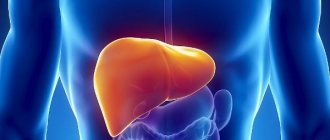Detailed description of the study
Laboratory study for the qualitative determination of hepatitis C virus RNA in blood plasma using real-time polymerase chain reaction. Recommended as a confirmatory study if the result of serological screening is positive. It can be used for early diagnosis (2 weeks after infection).
Hepatitis C is an infectious liver disease that develops as a result of infection with the hepatitis C virus (HCV). The source of infection is a sick person. The virus is transmitted by blood transmission, that is, through contact of damaged tissue of a healthy person with a small amount of blood from a patient. There is no vaccine against HCV.
Virus transmission is possible:
- during sexual intercourse;
- when applying tattoos;
- when using reusable medical instruments that have not been properly processed;
- with injection form of psychoactive substance use;
- during blood transfusion;
- during pregnancy and childbirth from an infected mother to a child.
The main target of virions is liver cells (hepatocytes). The virus binds to the cell membrane, followed by the release of its own genetic material - an RNA molecule - into the cytoplasm of the cell. After this, a mechanism for reproducing the structural elements and genetic material of the virus is formed in several stages. Next, new virions are assembled inside the cell and released outside the cell, after which the cycle repeats. In addition to hepatocytes, HCV is capable of infecting immune cells (T- and B-lymphocytes) and cells of the central nervous system, while remaining invulnerable to the body’s immune defense system.
The incubation period can last from 21 to 140 days, but more often it takes 50–60 days. In the early stages, the infection is often asymptomatic. Further, some patients develop acute viral hepatitis (AVH), which does not lead to destructive progression of the disease. OSH is characterized by symptoms of acute liver dysfunction: high fever, loss of appetite, dark-colored urine, light-colored feces, yellowness of the skin and whites of the eyes, joint pain. In approximately 20–30% of infected people, the virus disappears spontaneously no later than six months after infection.
In 70–80% of infected people, the disease becomes chronic (CHC) with a high risk of developing liver cirrhosis or cancer - hepatocellular carcinoma of the liver. Due to the absence of symptoms, an undiagnosed infection can develop for decades until secondary signs of dysfunction associated with the degeneration of liver tissue appear. According to experts, today more than 3.5 million Russians have a chronic form of HCV infection.
Diagnosis of chronic hepatitis C is carried out in three stages:
1. Screening detection of antibodies to HCV in the blood.
2. Qualitative and quantitative determination of viral RNA in the blood.
3. Determination of the genotype (out of seven possible) and subtype of the virus is a necessary study for choosing therapy.
A diagnosis of CHC is possible if viral RNA is detected in the patient’s blood for 6 or more months.
Hepatitis C antibody test: what does a positive result mean?
If the result is positive, this means that the disease has been detected or was previously present. In rare cases, the body successfully defeats the virus naturally. Therefore, a positive result does not always mean that a person is sick. This result indicates that the person was exposed to the virus, but it is not known for sure whether it remains in the body.
The same as negative. After all, antibodies can be hidden from the eyes of diagnosticians for 9 weeks after infection occurs.
Therefore, in practice, a PCR test is usually used, which determines whether the virus is in the body now. The most reliable is a combination of positive PCR and ELISA tests. This indicates the highest probability of the presence of the virus in the human body.
What are antibodies?
Antibodies are special proteins that are used in the immune response to the appearance of a virus in the body. They are produced in response to a threat. Accordingly, antibodies to hepatitis C are produced to help the body fight it. For more detailed information, we recommend reading a separate article about this. We discuss detailed information about hepatitis C antibodies in this article.
Should we be afraid?
Of course not. It can take anywhere from 10 to 40 years for the virus to actually do anything bad to the liver. It all depends on lifestyle and a number of other factors. Your doctor may prescribe treatment, recommend a diet, and offer some tips on how to prolong your life expectancy with this disease.
The risk of liver cancer is only 2-3%. That is, it is relatively small.
The doctor may also prescribe tests for viral load and determination of the genotype of the virus.
Is there a vaccine for hepatitis C?
There is no current vaccine yet. However, the search for her is ongoing.
For a long time, scientists have been unable to discover a stable viral protein specific to all genotypes and subtypes of the hepatitis C virus, for which neutralizing antibodies would be produced. The possibilities of genetic engineering technologies to create such a vaccine are being studied.
Currently, several teams of researchers are searching for technologies to create vaccines against the hepatitis C virus. According to WHO, a vaccine for the treatment of hepatitis C is undergoing clinical trials in Europe. There are several international projects to develop a preventive vaccine against hepatitis C.
What it is?
Hepatitis C, abbreviated as hepatitis C, is a viral, infectious disease that develops in the liver as a result of infection with the hepatitis virus (HCV). The virus spreads through contact with an infected person, namely through blood. Infectious hepatitis C has acute and chronic forms.
HCV is a small chain of ribonucleic acid (RNA) viral envelopes that uses material from liver cells for reproduction. The mechanism of RNA activity triggers inflammatory processes in the liver, gradually destroys liver cells (the process of cytolysis), triggers the immune mechanism for the synthesis of specific antibodies, autoimmune aggression of the body's protective functions in relation to inflammatory processes of hepatocytes (attack on healthy cells of the immune system).
HCV, genotyping (types 1a, 1b, 2, 3a, 4), RNA [real-time PCR]
Molecular genetic study to determine the genotype of the hepatitis C virus.
The used set of reagents can be used to diagnose hepatitis C virus and the most common HCV genotypes in Russia (1a, 1b, 2, 3a and 4) in vitro.
Synonyms Russian
Hepatitis C virus (HCV).
English synonyms
Hepatitis C Virus (HCV) Genotyping, HCV Subtype.
Research method
Real-time reverse transcription polymerase chain reaction.
What biomaterial can be used for research?
Venous blood.
How to properly prepare for research?
- Do not smoke for 30 minutes before the test.
General information about the study
The hepatitis C virus (HCV) can infect liver cells, as well as some blood cells (neutrophils, monocytes, B lymphocytes). The infection is mainly transmitted through blood (preparations for transfusion of blood and plasma elements, donor organs, non-sterile syringes, needles, instruments), less often it is transmitted through sexual contact.
Acute viral hepatitis is usually asymptomatic and in most cases remains undetected. 60-85% of those infected develop chronic infection, which increases the risk of cirrhosis, liver failure, and hepatocellular carcinoma. For its hidden but destructive effect, the infection received the unofficial name “gentle killer.”
HCV has the greatest variability among all pathogens of viral hepatitis and, due to its high mutational activity, is able to avoid the effects of the protective mechanisms of the immune system. The genomes of the virus differ significantly in different countries of the world and have different sensitivity to interferon drugs.
There are 6 main genotypes of the hepatitis C virus and about 500 subtypes. The most common genotype in the world is genotype 1 (40-80%). Type 1a is often detected in the USA, type 1b is typical for Western Europe and South Asia. Genotype 2 occurs with a frequency of 10-40%. Genotype 3 is common in Scotland, Australia, India and Pakistan. HCV type 4 is typical for Central Asia and North Africa, genotype 5 is for South Africa, genotype 6 is for some Asian countries. In Russia, genotype 1b predominates, then with decreasing frequency - 3, 1a, 2, in the USA - 1a/1b, 2b, and 3a.
Antiviral therapy aimed at suppressing the progression of the disease, in rare cases, can accelerate the development of liver complications. This occurs when clinical and laboratory parameters are incorrectly assessed. Hepatitis C virus RNA genotyping allows one to predict the effect of planned therapy.
Genotype 1 is less treatable than genotypes 2 and 3. In addition, it is more important to perform a liver biopsy in genotype 1. Increased doses of interferon drugs are recommended for patients with genotypes 1 and 4. The course of therapy in such patients should be extended to 48 weeks, even if there is no virus in the blood for more than 24 weeks. If treatment is successful, which is confirmed by a decrease in the viral load in the blood (
Genotypes 2 and 3 respond well to treatment in 80% of cases, usually within 24 weeks.
Treatment is developed taking into account the patient’s gender and age, presenting symptoms, previous therapy, liver structure and function, as well as laboratory parameters.
What is the research used for?
- To determine the need for treatment and predict the course of the disease.
- To plan the duration of antiviral therapy and drug dosage.
- To predict the effectiveness of treatment.
- To decide on a liver biopsy.
When is the study scheduled?
- When detecting hepatitis C virus RNA and planning antiviral therapy.
What do the results mean?
Reference values: HCV RNA not detected.
When detected, the genotype is indicated:
| Result | Meaning |
| Genotypes 1a, 1b | Very high risk of chronic infection and development of severe complications. Treatment with higher doses of interferon is required for 48 weeks. |
| Genotypes 2, 3a | In most cases, the planned therapeutic effect is achieved within 24 weeks. |
| Genotype 4 | It is more difficult to treat and requires doses of drugs different from those used in therapy with genotypes 2 or 3. |
What can influence the result?
- The genotype of the hepatitis C virus is sometimes not detected when the concentration of the virus in the blood is less than 1.25*10^3 IU/ml.
Important Notes
- The decision on the duration of therapy, the required dose of drugs and cessation of treatment can only be made by the attending physician based on biochemical tests of liver function, biopsy (if necessary) and viral load.
- There is a possibility of re-infection with viral hepatitis C of a different genotype due to the lack of cross-immune response and stable immunity.
Also recommended
- Anti-HCV, antibodies, ELISA
- Anti-HCV, antibodies
- Antibodies to structural and non-structural proteins of the hepatitis C virus
- HCV, RNA [real-time PCR]
- HCV, RNA quantitative [real-time PCR]
- Gamma-glutamyl transpeptidase (gamma-GT)
- Alanine aminotransferase (ALT)
- Aspartate aminotransferase (AST)
- Total alkaline phosphatase
- Serum albumin
- Total bilirubin
- Total cholesterol
- Thrombin time
- Fibrinogen
- Complete blood count (without leukocyte formula and ESR)
- Leukocyte formula
- Erythrocyte sedimentation rate (ESR)
Who orders the study?
Infectious disease specialist, hepatologist.
Literature
- Vozianova Zh. I. Infectious and parasitic diseases: In 3 volumes - K.: Health, 2000 - T.1.: 600-690.
- Kishkun A. A. Immunological and serological studies in clinical practice. - M.: LLC MIA, 2006 - 471-476 p.
- Germer J., Mandrekar J., and others. Hepatitis C Virus Genotypes in Clinical Specimens Tested at a National Reference Testing Laboratory in the United States. J Clin Microbiol. August 2011; 49(8): 3040–3043. PMCID: PMC3147781.
- Kuzin S., Samokhvalov E., Zabotina E., and others. Hepatitis virus genotype structure in patients with chronic hepatitis C. Zh Mikrobiol Epidemiol Immunobiol. 2011 May-Jun;(3):33-8. PMID:21809642.
- Mahaney K, Tedeschi V, Maertens G, et al, “Genotypic Analysis of Hepatitis C Virus in American Patients,” Hepatology, 1994, 20(6):1405-11. PubMed 7982639.
- Paintsil E, Verevochkin SV, and others Hepatitis C virus infection among drug injectors in St. Petersburg, Russia: social and molecular epidemiology of an endemic infection.Addiction. 2009 Nov;104(11):1881-90. Epub 2009 Aug 27. PMID:19712125.
Symptoms of chronic hepatitis C
Unfortunately, in 70-80% of cases, hepatitis C has a primary chronic course. For many years the disease flows hidden, practically without showing itself. The person is unaware of his illness, leads a normal lifestyle, drinks alcohol, aggravating his condition, has unprotected sex and infects others. Liver function in hepatitis C remains compensated for a long time, but often such imaginary well-being ends in acute liver failure.
What indirect signs can lead a person to think about liver dysfunction?
- Dull pain under the right rib, periodic nausea, loss of taste. It is important to understand that with the gradual death of liver cells, the remaining tissue mass increases compensatoryly. The liver increases in size and stretches the liver capsule, causing pain. Since this happens gradually, cirrhosis of the liver due to hepatitis is not characterized by sharp or acute pain.
- Weakness, lethargy and drowsiness. Extremely nonspecific symptoms characteristic of many diseases, but patients with hepatitis often characterize their weakness as “terrifying.” “I can’t open my eyes,” “I’m ready to sleep 20 hours a day,” “my legs are giving way”—infectious disease doctors often hear these characteristics.
- Periodic yellowing of the skin and mucous membranes. In the chronic course of hepatitis C, jaundice appears and disappears. Often patients note a slight yellowing of the sclera or skin the morning after a festive dinner with an abundance of fatty foods, meat and alcohol. Thus, on normal days the liver copes with the exchange of bilirubin, but after a “double” hit of fatty foods and alcohol, it temporarily fails.
- Joint pain is also a nonspecific symptom of hepatitis, but occurs quite often.
- The appearance of bruises, hematomas, spider veins, excessive bleeding of the gums, and heavy menstruation in women indicate a deficiency of blood clotting factors, for which the liver is responsible.
- Dry and pale skin, hair loss, brittle and flaky nails are the consequences of a lack of vitamins and iron metabolism disorders, for which the liver is responsible. Often, patients with hepatitis have a severe lack of B vitamins and iron, leading to anemia (anemia).
- Impotence and infertility are often observed in patients with hepatitis C. The inability to conceive a child, recurrent miscarriage are often observed in female carriers of hepatitis C. The main “sexual” symptoms of hepatitis C in men: impotence and spermatogenesis disorders. This occurs due to a violation of the metabolism of sex hormones, which necessarily undergo their transformations in the liver.
- Edema syndrome and its extreme manifestation is ascites. Edema occurs due to insufficient amounts of protein and nutrients in the blood. Ascites is an accumulation of fluid in the abdominal cavity with a proportional increase in the abdomen, which the patient notices. This occurs due to impaired blood flow in the vessels of the abdominal cavity. This symptom is characteristic of liver cirrhosis due to hepatitis. Sometimes up to 20 liters of fluid accumulate in the abdominal cavity.
Most often (in approximately 70% of cases), there are no symptoms of either acute or (subsequently) chronic hepatitis for many years; the infected person is bothered by increased fatigue, periodic heaviness in the right hypochondrium, and intolerance to intense physical activity. In this case, carriage of the virus is determined by chance during preventive examinations, during hospitalization or an attempt to donate blood as a donor.
Symptoms of hepatitis C in women and men
The incubation period of the disease before the first signs appear lasts from 1.5 to 6 months (on average 2–3). Acute hepatitis C (see photo) is characterized by a benign course, the condition quickly normalizes, the symptoms of the disease are mild or moderate:
- unexpressed dyspeptic symptoms (1-2 times vomiting, heaviness or dull arching pain in the right hypochondrium, unstable stool, nausea, loss of appetite, feeling of bitterness in the mouth);
- a rise in body temperature to subfebrile levels (noted by about a third of patients), high fever is uncharacteristic;
- liver enlargement;
- icteric staining of the skin and visible mucous membranes, icterus of the sclera;
- dark coloration of urine, discoloration of feces.
It is characteristic that the severity of the disease in acute hepatitis C is less pronounced than in other forms of viral hepatitis. Recovery from an acute process occurs in 15–35% of infected individuals; in other cases, the disease becomes chronic and continues for many years and even decades.






